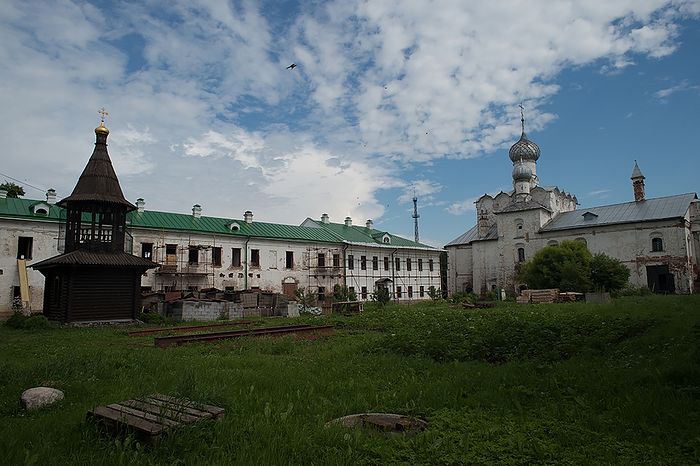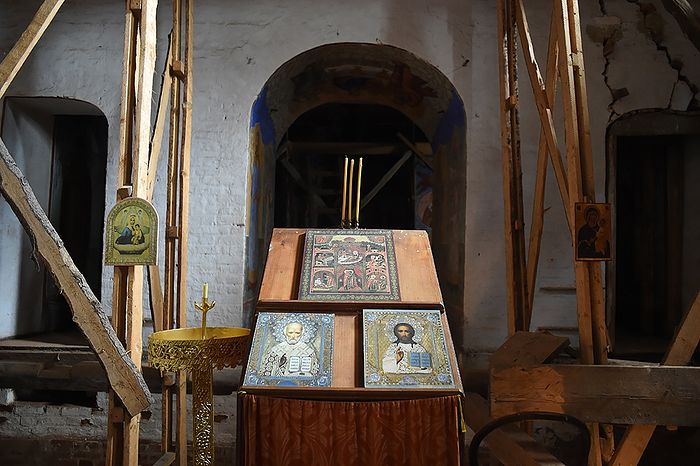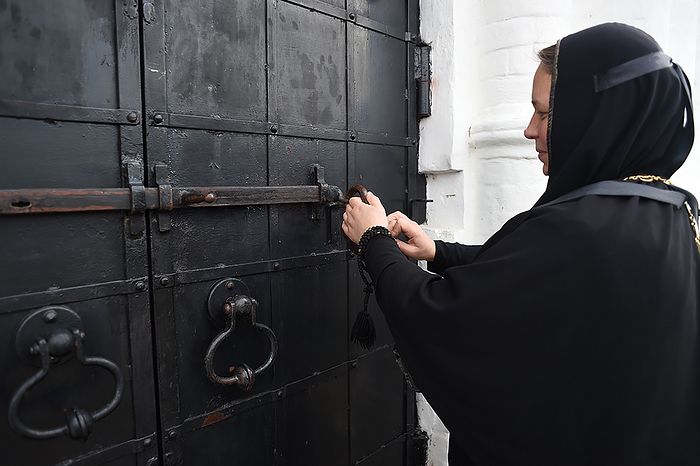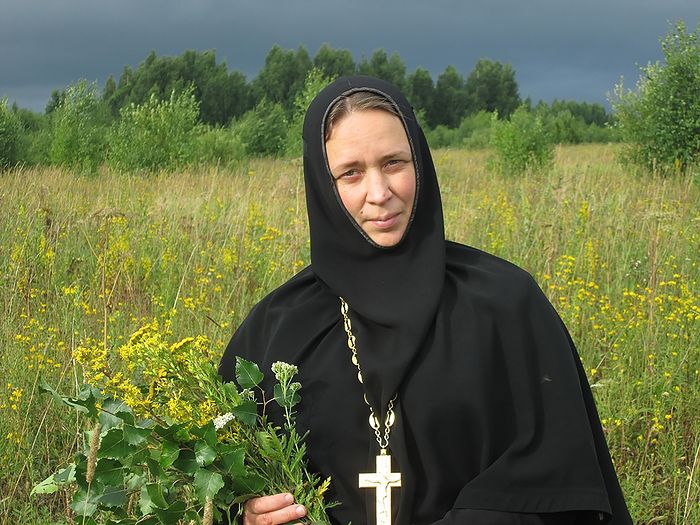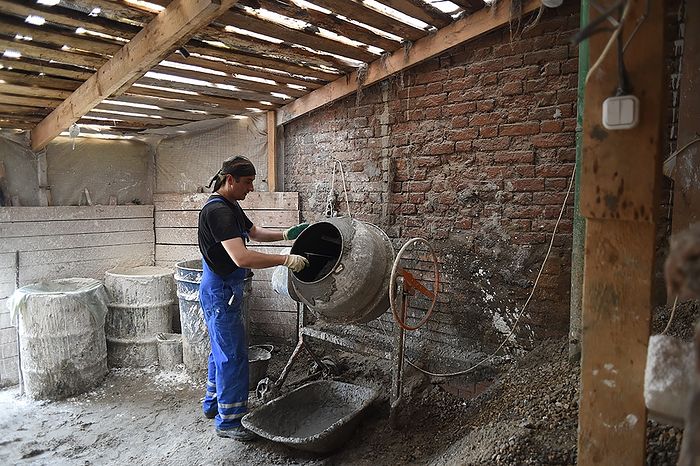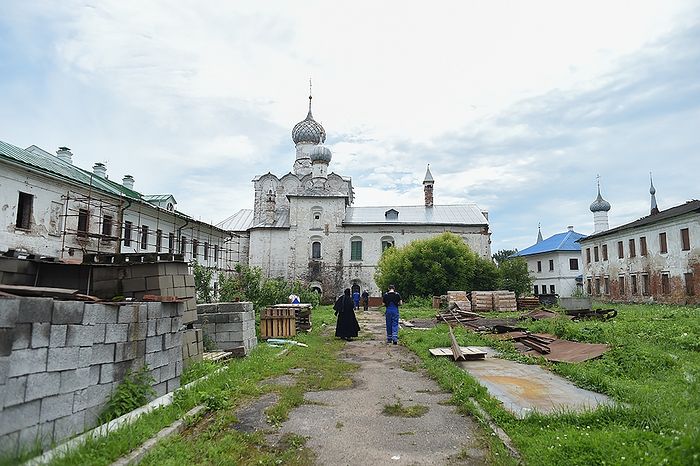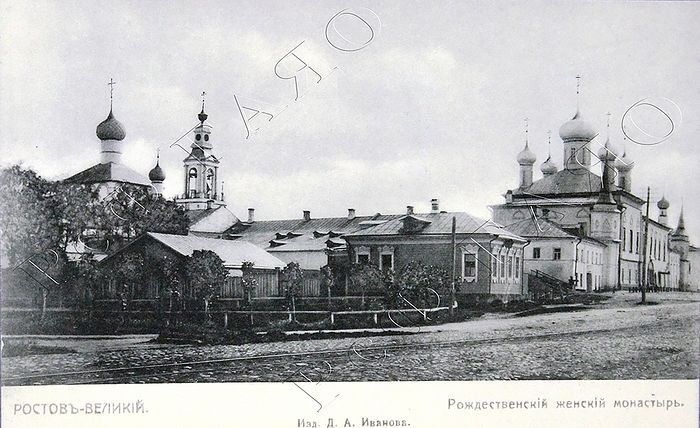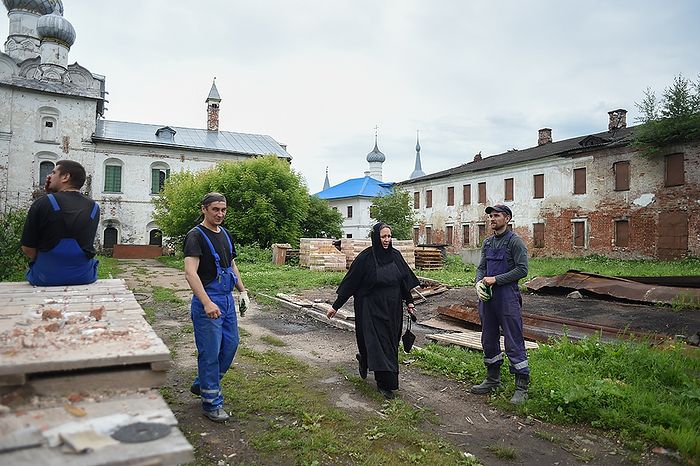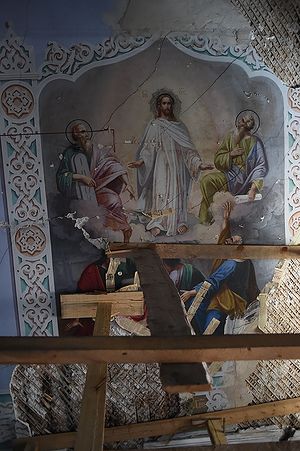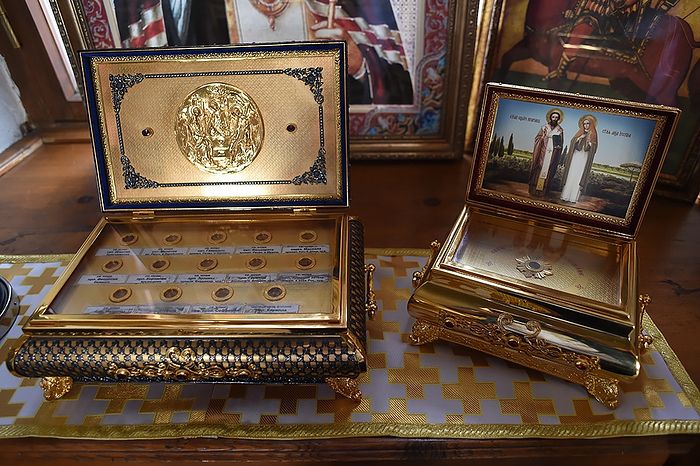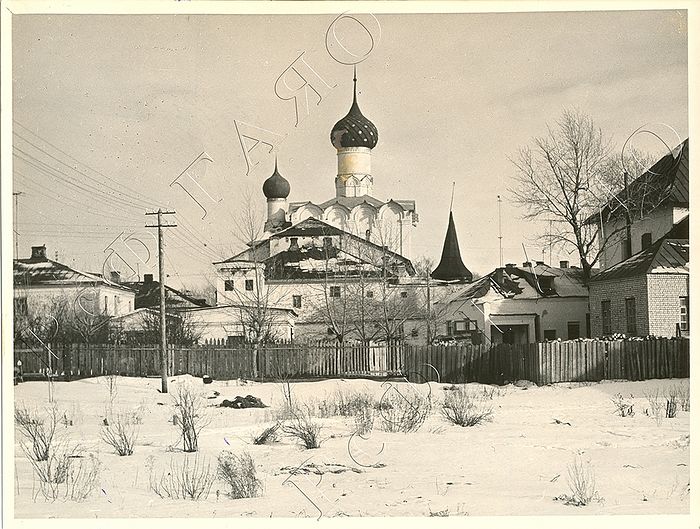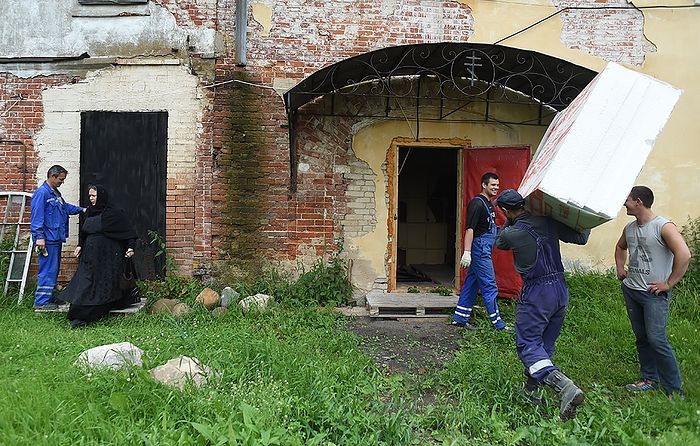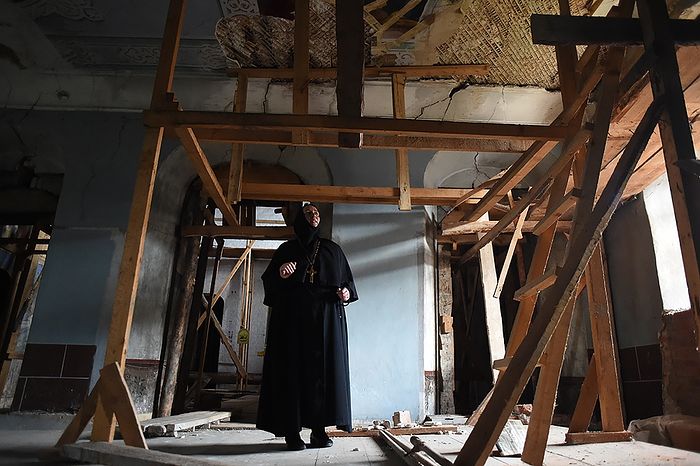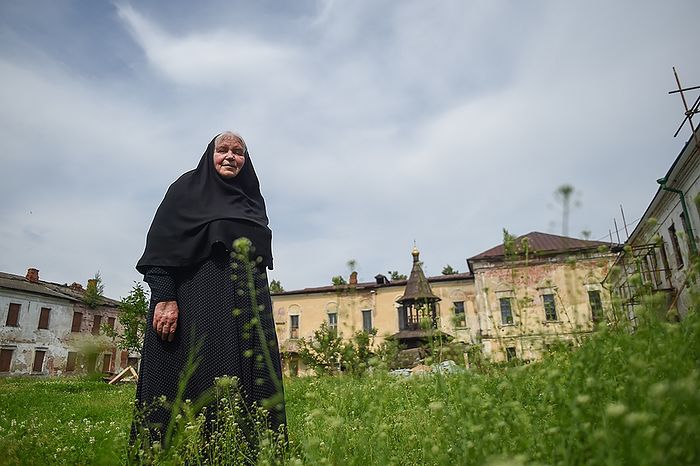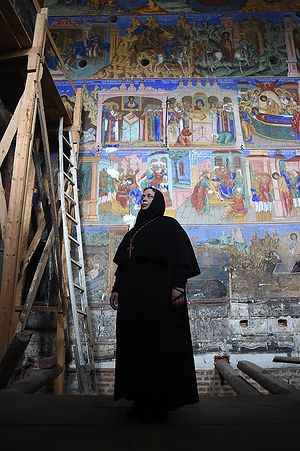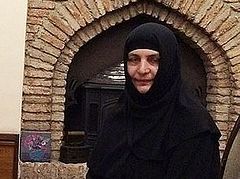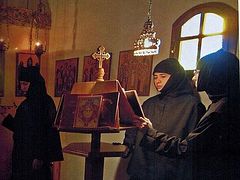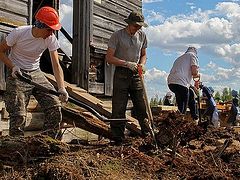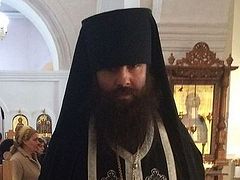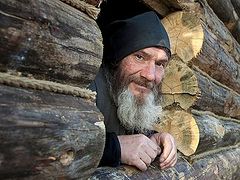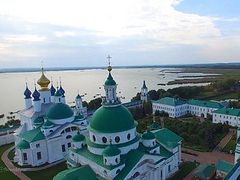The Convent of the Nativity of the Most Holy Mother of God - one of the oldest centers of monasticism in Russia’s Yaroslavl region—stands in the historic center of the town of Rostov Veliky, near the Rostov Kremlin and on the bank of Lake Nero. But visiting this place is not included in the famous “Golden Ring of Russia” tourist itinerary. Only a few can see this splendid monument of old Russian art today: the convent is not open for pilgrims. The nuns (and there are only three of them) “inherited” a dreadful legacy: the territory littered with construction waste, leaking roofs of the buildings, the poor condition of the nuns’ living quarters, the lack of basic facilities and the crumbling Cathedral of the Nativity of the Mother of God (built in 1680, a monument of federal importance). The sisters are in dire need of help in order to restore the convent from ruins and preserve the unique cathedral before it becomes too late to restore anything in it.
“If anybody wants to give alms to nuns, let him do it. He will receive a greater reward than he who gives alms to the blind, the lame and lepers. He who is able to give alms to nuns will receive a great reward and a great crown from God.”
—St. Isidore of Pelusium
A convent without a church
By the time of our arrival at the convent (126 miles north-east of Moscow) the service had ended. Frankly, we hoped that over our two-day stay at the convent we would have time to attend a service; so we took our time driving to Rostov, admiring the old country churches and lovely Russian rural landscapes en route.
Besides, the abbess had warned us in advance: she said that services at the convent were held once a week. But since we were going there on the eve of the centenary of the martyrdom of the Holy Royal Family,1 which was followed by the feast-day of St. Sergius of Radonezh and Grand Duchess Elizabeth the New Martyr (the sister of the Holy Tsarina Alexandra Feodorovna), we were sure that we would be able to attend a service.
Unfortunately, the priest couldn’t come and so the service was cancelled. Then we understood how the nuns feel when services are not celebrated at the convent.
“That’s the way we live,” Abbess Athanasia complains. “Have you ever seen anything like it? A convent without a church! The nuns have to leave the convent’s territory in order to go to a service. There is St. Nicholas Church attached to our convent [the Church of St. Nicholas of Myra on Podozere, completed in 1745 and consecrated by Metropolitan Arseny (Matseevich) - auth.], but it is across the street, and at times it is not safe here. Though the convent is relatively close to the Rostov Kremlin, it is considered ‘an uptown area’; the embankment is near and muggers like to walk there at nights. Every night we lock both the church and the convent with multiple locks and turn the church alarm system on.”
The convent is not open for the public, yet it has many relics. The St. Nicholas Church has several reliquaries with portions of the relics of different saints (including rare relics), and the reliquaries themselves are real masterpieces of art. If a pilgrim or a tourist pops in at the St. Nicholas Church on the outskirts of Rostov Veliky, he will be stunned by seeing this hidden treasure!
The main relic of the Holy Nativity Convent is a copy of the wonderworking Tikhvin icon of the Mother of God (kept at St. Nicholas Church to the right of the entrance).
“When it was the fifth Saturday of Great Lent—of the Akathist to the Theotokos—the icon began exuding myrrh,” Mother Athanasia relates. “Then we had a shortage of finances and were in a critical situation. It seemed that there was no way out and we were at a deadlock. I didn’t know how we would live on. We implored the Mother of God to intercede for us before Her Son, our Lord Jesus Christ, so that He might solve our problem, for there are no dead ends for God. And the All-Holy Virgin comforted us, so we were heartened and inspired and ‘stood upon firm ground’. All our sorrows were overcome and problems fixed.
“Significantly, the holy myrrh flowed out of the right hand of the Theotokos on the icon, and it is this right hand that She reaches out towards the blessing Christ Child imploringly. That is why it is important to believe that help is near, to turn to the Creator, the Virgin Mary and saints with pure heart. A sincere prayer will always be answered.
“When we came here in 2011, we found that dogs were running on the convent’s territory, homeless people were living and thieves wandering here, and now saints are making their home here. People often bring holy objects to the convent: icons and particles of saints’ relics. In a spiritual sense, we see it this way: these saints by the grace of God have deigned to move to our convent, they have come to support us. We feel that now there are many of us in the nunnery, and the difficulties are being overcome with hope, faith and prayer to these saints.
“We don’t count on our own strength. Once a monk thinks that he is able to do anything himself, he fails immediately. We ask the Lord to be merciful to us and to those who were merciful to us as well. Our life is simple and unsophisticated. The grandest, worthiest and most splendid things are used for church services. St. Basil the Great used to serve in magnificent robes, while he was very modest in his life.”
“The keys to Paradise”
—Matushka, what did you feel when you went here? The monastery was in total desolation at that time.”
There was neither running water nor gas. And the whole area was all in ruins with heaps of trash and debris. The land was not registered as the convent’s property, the buildings were still not transferred to the Church, there was no design documentation. And, finally, there were no nuns. Today there are three of us, but before the Revolution about 200 sisters lived here!
The living quarters were in an appalling condition. We could live only in the abbess’ residence. The convent had no fencing so we had to install a fence ourselves. But for this people filed a complaint to the Office of the Public Prosecutor saying that what we were doing was a ‘health hazard’ for locals,” Mother Athanasia continues her story. “There were potholes instead of a path leading to the convent. People did not go here. And there are still not many parishioners in the church. But those who come regularly are our permanent parishioners and they love our church. For example, today a large family came for the service, another family comes each time.
We cannot keep the church open all day long: it is difficult for two aged sisters to stay here all the time, they need to rest. If we hire somebody, we will need to pay him money. And where will we get the money? In big convents sisters take turns in ‘keeping watch’ at the church—it is a part of their obedience. That is sadly impossible here. There are only three of us and we are struggling to survive.
There is another problem: people come to the church and cannot understand—where is the actual convent? This is why it is vital to restore at least one church on the territory of the convent.”
In 1997 two nuns from Tolga Convent near Yaroslavl—a mother and a daughter—were sent here to revive monastic life at the convent. Later, novice Lydia joined them. As both nuns were ageing, all the household chores, works on the restoration of temples and clearing the territory were heaped on novice Lydia’s, now Mother Athanasia’s, shoulders. She is the abbess, the steward, the abbess’ assistant, the senior chorister, the choir director, the chorister, the reader, the acolyte and the bell-ringer at the same time…
A car was donated to the convent so I had to learn to drive the car and to get my driver’s license. Thus I became a driver as well (smiles). It is always helpful to have your own transport. I had walked so many miles on foot before… Obviously the Lord took pity on my feet. And earlier I would pull a handcart loaded with cement together with workers through the town. Fortunately, Rostov is a small town—it is not like Moscow.
I am a teacher by profession and I taught geography and biology at a school before becoming a nun. I also could teach ecology and chemistry. I was also the director of studies at school. I came to believe in God when I was a student. Once Archpriest Stephen—rector of the church where at that time I read in the choir, led a Sunday school and helped organize a library—said to me: ‘I am praying for you, and you are to become an abbess in the future!’ I thought: ‘The batiushka is joking!’ I was then twenty-three. But six years later I joined a convent…
Before Rostov Veliky I had lived at Tolga Convent for nine and a half years. And when I came here I had to learn to live in a new world. Imagine that you have been sent to a city which is unfamiliar to you, where you know nobody and nothing; and I was given neither money nor documents for the convent. I was naïve to the point of absurdity. There were lots of cheats ‘hunting’ around me. Just my outward appearance gave away my naivete. But as soon as the swindlers realized that they wouldn’t ‘get anything out of me’ and that there was no money at the convent, they would vanish. Then it was explained to me that the frauds had tried to “con” me into giving them a good sum of money. But, frankly, I had never heard this word before (laughs) [the Russian word “razvesti” is used here which in a modern slang means “to trick or con somebody out of something”].
Can you imagine? I didn’t know the meaning of the words ‘a USB flash drive’ or ‘e-mail’! During the first year people ‘translated’ modern slang words into normal Russian so as ‘to put me in the picture’, as the modern saying goes. That’s what coming from another world—from a convent—is all about. Only nine and a half years passed, but the world had become very different!
One has to live here for some time in order to understand what we experienced and felt at the convent when we moved to Rostov. We were sent here as ‘paratroopers’ to get our weapons in battle. We feel as if we were on a submarine—we can only move forward. But we are not scared! As the saying goes, when you’re afraid of something, you won’t do it. The most important thing is not to fear. I am looking into the future without fear, and I trust God. But when I turn back in my mind’s eye, I am fear-stricken because of the Lord’s closeness. Our convent is being restored not by human efforts—it is the work of God.
When the convent was entrusted to me, the priests took me around the buildings and showed me the “household”. Every single door was locked. They unlocked all these doors, fitting a key to each of them; but everything was swimming before my eyes and I couldn’t memorize the location of things at all. There was a kitchen sink in the abbess’ quarters, but with no faucet! ‘Where is the faucet?’ I asked perplexedly. ‘There is no water,’ the priests answered. I was dumbfounded. After all, we live in the twenty-first century…
Eventually the convent’s documents, seal and a bag of keys weighing several kilos were handed over to me. One of our assistants called the bunch of keys that I always carry with me ‘the keys to Paradise’.
The first thing I did was to raise funds to have water supply pipes installed at our convent. And I had to go through so many trials and painful experiences here! The organizations would answer me: ‘It is a town on the Golden Ring of Russia! How can it be that you have no water?! We don’t believe you!’ So I had to show them the documents and prove that I was not a fraud.
When we had no gas we burned firewood and used charcoal. We have had the water since 2012 and gas since 2014. The buildings that we are beginning to use have a gas supply. Some of the buildings are in an acutely dangerous condition. But I won’t get down to the work on their restoration until the Lord sends us resources.
As an office-holder I have had to do so many things myself! Though in Russia the Church is separated from the state, you can’t imagine how many reports I have to submit on the work I’ve done! The convent has no wage workers due to the lack of finances; even so, it is forced to send all sorts of declarations and reports, though with zero indicators. Once I even was cited.
—Mother Athanasia, what did you feel when you were denied assistance? How did you take it?
—At first I was very upset. I had to travel a long way to Moscow each time and I would come back very weary and disheartened because of unsuccessful attempts. Once I got so discouraged and grumbled: “Oh Lord, why am I going through these severe trials?” Then I came to my senses and said to myself: “Stop! Trials? [“trials” and “afterlife aerial tollhouses” which are present in the Orthodox tradition—are expressed by the same word in Russian—“mytarstva”]. If I am experiencing trials, then it means that they have been sent by the Lord. It is better to endure them on earth than to suffer them after death.”
Next the following thought came to my mind: “Why are you fussing about all the time? Do you have faith? Be quiet and pray peacefully, and the Lord will grant it to you in due course.” And in this state of mind I opened the Gospel to a random page and read: Now when He had left speaking, He said unto Simon, Launch out into the deep, and let down your nets for a draught. And Simon answering said unto Him, Master, we have toiled all the night, and have taken nothing: nevertheless at Thy word I will let down the net. And when they had this done, they inclosed a great multitude of fishes: and their net brake (Lk. 5:4-6). And I thought to myself: the Lord has already answered me. Who knows, in which moment my net will be full of fish.
It was then that I came to understand that the matter was not that I turned to various people, seeking funds and asking for help. The matter was that my conversations with them every time began with preaching. I would tell them about the convent, and they would ask me how I ended up there. Little by little our conversation would turn to faith, the Church, spiritual life. Sometimes people remain indifferent, but sometimes this evokes a warm response.
I realized that I should go and speak. The Lord does not let me just sit and wait. Every attempt to appeal to somebody for help passes through my heart. It is the work of divine Providence, whereas I am a mere participant. We as humans want results, while what matters for God is the very path, the period of time needed for the convent’s rebirth. It is also important that new people should come to the convent or donate to it, for God has a unique different plan for each single individual. The Mother of God wants people to support this convent, Her abode, because thus they contribute to the salvation of their immortal souls and of those of their nearest and dearest.
We cannot fully characterize the results of these events because they may even have an effect on the future generations. We are building the convent in a visible way. We are bustling about, worrying, communicating, making arrangements, seeking funding. And what happens on the invisible (spiritual) level? The house of God, the spiritual world is being built of our souls as if they were bricks. This is the purpose of our presence here: we are learning to live in the convent.
If kids have never played together in a sandbox, then how will they learn to be friends? Likewise, when we are in contact with each other we reveal the traits of our souls to the Lord—what we are capable of “in a good sense”. Meanwhile, we reveal to ourselves what we are capable of “in a bad sense”. And it is our experience, too. When you are on your own you look so nice, but once you are in contact with others you begin to see numerous sins and imperfections within yourself, thus a reason for repentance and self-reform appears.
A revival of what was lost
The Convent of the Nativity of the Mother of God in Rostov Veliky was founded in the fourteenth century by Archbishop Theodore of Rostov, a nephew of the Venerable Sergius of Radonezh. Until the seventeenth century all the buildings were wooden.
Stone was first used towards the end of the seventeenth century, under Metropolitan Jonah (Sysoyevich), a prominent builder of churches in the Diocese of Rostov. The first stone church was built and consecrated in honor of the Nativity of the Blessed Virgin (in the 1680s)—it was an imposing two-storied structure.
However, numerous alterations and losses—the bell-tower was demolished, the five cupolas of the gateway Church of the Tikhvin icon of the Mother of God (the mid-nineteenth century) collapsed, the towers and walls only partly survive—distorted the nunnery’s appearance. But, nevertheless, the surviving architectural aspect gives us an idea of the artistic taste of the era and reveals that there were talented builders in Rostov at that time. Some suggest that the Cathedral of the Nativity of the Virgin Mary was constructed by the same masters who built the Kremlin churches. The convent’s churches and buildings were returned to the Moscow Patriarchate in the late twentieth century.
In 2015 the restoration of the convent’s north-east living quarters began. The work has been progressing slowly (due to the shortage of funds) and everything has been done manually. We observe the master builder carry a long block of metal weighing several dozen kilos on his shoulders.
“We have been restoring the building in its original form. For example, the cornices are made of natural gypsum,” Abbess Athanasia explains. “The interior finish is very plain, we have been using water emulsion paint. However, the construction and restoration work is of good quality.”
The “enclosed” saints
Mother Athanasia leads us to the Cathedral of the Nativity of the Mother of God. In order to enter the cathedral you need to ascend a long iron staircase with some ornate décor on the steps.
Among the people who mounted this stairway were St. John of Kronstadt, the Holy Patriarch Tikhon (Belavin), the Hiero-confessor Agathangelus of Rostov, Empress Maria Feodorovna, Countess Anna Orlova-Chesmenskaya.
The cathedral is in a disastrous state: there are no floors, the frescoed walls have ugly cracks in them caused, according to the experts, by subsidence under the cathedral’s foundations; as a result of many years of leaks in the vault the frescoes are covered with a layer of growing as well as drying mold and dust; the door arches and the refectory ceilings are held up with wooden props to prevent lumps of plaster falling on the heads of visitors.
“Note that the cathedral’s interior decoration is well thought out,” Mother Athanasia continues. “The Queen of Heavens spreads Her veil over all who go into and out of the church, thus reminding all of us that we are at Her home and under Her protection.”
In the last century the roof was not put on properly, and the snow load caused a protrusion which, in its turn, caused leaking. As a result the frescoes began to flake off, though they can still be saved with the use of modern technologies: they can be carefully taken off and then placed back on the well-prepared and reinforced walls and ceiling.
The refectory has two tiers, and the vaults are supported by a pillar which goes down to the foundation into the cathedral’s basement. There are two churches beneath us—with a large and a small altar respectively, dedicated to St. Alexis, the Man of God, and St. Dimitry of Rostov.
In the Soviet era the paintings on the refectory ceiling were mercilessly covered with white paint. But those people obviously either did not have time to finish their work or ran out of paint, so they stopped right in the center of the fresco, Christ the Pantocrator.
Here and there you can spot scaffolding and wooden props supporting fragments of the frescoed walls to prevent them from falling.
The central altar of the upper church is dedicated to the Nativity of the Holy Theotokos. The left-hand side-chapel was formerly dedicated to the Holy Unmercinaries Cosmas and Damian but later rededicated in honor of the Holy Trinity.
In the central cube of the cathedral the paintings date back to the time when it was built of stone (it had been wooden before then). In the Soviet period it accommodated an archive. Its staff workers recalled that even at that time they were filled with awe when entering the altar each time. It was the work of the grace of God present at the church.
The paintings of the Cathedral of the Nativity of the Mother of God (1680-1715) were created by the same masters who made the paintings for the Metropolitan’s Chambers (the Rostov Kremlin). This provides further evidence that the cathedral is public heritage, a historic monument of federal importance. Today the cathedral is in such a disastrous state that we risk losing this unique legacy.
“We have no right to restore anything at the cathedral on our own. It is prescribed by many articles of the law, such as ‘On Damage to Historical Monuments’,” the abbess says. “The Lord Himself is showing us that we should ‘rouse’ in our hearts a sense of duty towards the national shrine; the frescoes are renewing themselves. The Savior is knocking and waiting, if anyone hears Him and opens the door.”
“In 2011, the lower tier of frescoes was dark, and now silhouettes, the events of the Biblical history can be distinguished. Now the inscription, reading ‘Christ before the People’ is discernible—earlier it was illegible,” Mother Athanasia casts a glance at the walls. “We have an impression that the frescoes are renewing themselves: they are becoming clearer, brighter and their colors more saturated. It is not only our observation; people come here after some period of absence and notice that the changes are obvious.”
And the acoustics of the building are amazing! It is not echo, which is unacceptable at the cathedral and impedes reading—what the cathedral has is called phonation. Look here, these hollows are resonators. Today builders of churches are trying to create a similar kind of acoustics using modern electronic devices, but without success—the results are not satisfactory. And we can lose such a great treasure!
The paintings and frescoes need restoration: they are unique and you cannot find similar ones in modern churches: restrained and subdued hues (that is fitting for monks), expressive figures, piercing faces and, most importantly, the eyes of saints. Some of the saints have lively yet sad eyes—the eyes of saints “enclosed” in scaffolding: Greatmartyr Anastasia, St. Sergius of Radonezh, St. Isaac, the Crucifixion of Christ with Bystanders…
A rare painting of the Holy Trinity survives above the entrance to the altar, with the images of the Holy Archdeacons John, Philip, Laurence and Stephen on either side. The frescoes inside the altar are intact.
The Trinity Chapel is small. The window in the altar is boarded up. The walls and the ceiling are covered with blue paint. There is barely anything left here apart from an image of the Mother of God above the entrance, an inscription of the foundation of the chapel, a painting “The Appearance of Christ to St. Mary Magdalene”, images of the Holy Unmercenary Physicians Cosmas and Damian.
“I was raised at the Holy Trinity—St. Sergius Lavra, and I love all that is associated with the Holy Trinity and St. Sergius. So when I learned that this convent had been founded by St. Sergius’ nephew, the Holy Archbishop Theodore of Rostov (he served as archbishop here for four years, his relics are kept at the Rostov Kremlin’s Dormition Cathedral—under the floor) and he dedicated it to the Nativity of the Mother of God (on this feast the Grand Prince Dimitry Donskoy had won his victory at Kulikovo Field), and that there is a side-chapel in honor of the Holy Trinity at the convent’s cathedral, I was filled with joy,” Abbess Athanasia says. “The side-chapels at the Church of the Tikhvin icon are dedicated to St. Nicholas the Wonderworker, the Greatmartyr Barbara and the Tolga icon of the Mother of God—all of them have been protecting my family.
“Our convent is closed to public and I take it so hard. The cathedral is in a state of emergency and so we cannot have pilgrims here. All that we can do is read akathists at the cathedral. But that is so unnatural! The convent should be open to visitors, the Eucharistic Prayer should be performed in it. But now its body is here, whereas its heart beats outside the gates—at a church across the road, as if it were in a bottle of physiologic saline. Its heart must ‘move’ into the body, as the Eucharist must be performed within the convent. Our situation is unique: our nunnery has no church where the Liturgy can be celebrated!
“The Cathedral of the Nativity of the Virgin Mary is a monument of federal importance, a significant object, national heritage, and it requires large capital investment. It is not due to the Church that this cathedral has fallen into a ruinous state but due to mishandling under the atheist regime.
“We have prepared a package of documents for the execution of emergency construction. But this is in theory, while in practice the situation is different. For instance, designing serious sites requires considerable expenditure of funds, but where can I find money? I need to approach people who potentially can aid me. I must explain to them that I need money for a project so that what will be our cathedral could be recorded on an electronic medium. However, few people will be willing to donate: They fail to understand why they should invest substantial amounts of money on ‘mere paper’. But it is vital. We are currently restoring the living quarters and architects, designers are involved in this work, with a designer’s and engineer’s supervision.
“The Diocese of Yaroslavl is one of the oldest Russian dioceses. Three years after the Baptism of Russia (Rus’) by Prince Vladimir the Diocese of Rostov (now Rostov Veliky) was founded. There are 163 objects of federal importance on the territory of the Yaroslavl region. Our cathedral ranks with other national monuments that share the same significance, and thus a question arises: To what should we give preference? As far as I know, the diocese can propose only one project to the federal program per year, while the rest of the sites have to wait. What shall we do? Wait for our turn for 163 years? But the cathedral will have collapsed by that time! Every month of delay is a step towards a catastrophe.
“And if there are a great many potential objects in our diocese; what should we do in order to be among ‘the select few’? Saying ‘my church is the best! Restore it first!’ will mean acting against my conscience. I wholeheartedly trust God and try to take everything with humility. As for us, we can wait, but the cathedral won’t wait...
“The convent stands 200 meters [c. 218 yards] away from the Kremlin and it is a monument of the same significance; however, it is turning to ruin before our very eyes. Emergency repair work must be carried out at the cathedral first of all. It is federal property, and the Ministry of Culture is responsible for it. The diocese has only been using this property.
“I have already appealed to many organizations, famous for their charity work, and was sure that they would help me. But I was turned down by all of them. Some of them replied that they were already helping many people; others said that their charities were active only on the regions of their commercial presence; others even answered that the end of the world is at hand and there is no point in building anything now; and, lastly, some responded this way: ‘Stop building churches! Your parish is tiny as it is; why do you want this cathedral?!’
“But if this cathedral was built before us, then its angel is now weeping at the sight of its ruinous state. And if people support it, then we will make the angel glad. And even if the last day comes while we are at work, what is wrong with it? We have taken a brick and are going to lay it into the foundation of our future church. ‘As I find you, so will I judge you,’ the Lord says. And if the last day comes while we are sitting and glancing idly out of the window, what will the Lord ask us about? What did we see from the window?
“For me the convent is like a child whose mother cannot settle his affairs because of her poverty. The child is rejected by everybody, the mother’s heart aches and she tries to assure them that her little one, homely as she is, is nevertheless talented. So, this is how I respond to things like these now: If a door closes, I look out for the window that opens. We need to walk this ‘way of the cross’. If the Lord didn’t want this convent, I wouldn’t be here as its abbess now.
“It seems the Lord has arranged that our cathedral is to be restored by the contributions of ordinary people, for the most ordinary folk are responding. So I am walking this path: looking for various organizations and people that can help us purchase building material and so forth. Some lay-people who have been aiding us have created a group dedicated to our convent on social networking websites. Marina and Dmitry are in charge of this.
“The Almighty has been sending us people to assist us. Isn’t it a miracle?! For example, a female convent laborer has recently come from Moscow for a fortnight with the blessing of the confessor of Sretensky Monastery.”
Tales on the altar walls
“The nunnery has seven altars in total. The Church of the Tikhvin icon of the Mother of God with three altars was built from the late eighteenth till the early nineteenth centuries in honor of the Tikhvin icon (it first appeared in 1388 in Tikhvin in what is now the Leningrad region and in 1390 the Nativity Convent was established), painted by the convent’s founder St. Theodore of Rostov. In the Soviet era parts of this temple were used as a bank office, a library and flats. It is a monument of regional importance.
Inside the church has a suspended ceiling which conceals the surviving paintings on the vault. The altar was carelessly partitioned off from the rest of the church by a brick wall. There is a nursery room inside the altar and the walls are painted with scenes from Alexander Pushkin’s tales.”
“Iron pipes with the frozen water ran around the perimeter of the ceiling. I and an assistant of ours cut through them—we tied them to a rope on hooks, while I kept an eye out and Vladimir cut off one end of the pipe, which then hung down, then he got down on the floor and we pulled the other end down together. That was a whole ‘operation’,” the abbess smiles.
“The church must be connected to the heating system,” she continues. “We are currently raising funds in order to pay the people who developed the church design. We would like to open a library and a church shop in the building adjacent to the temple so as to avoid any trade inside the church.”
A convent is not a collective farm
“Formerly, when faith was prohibited, monastic life was a sort of podvig [a heroic undertaking in this context]: people took up monasticism the political system notwithstanding,” Abbess Athanasia notes. “Nowadays all that is needed is your sacrifice—whether or not you are ready to do it for the Lord’s sake. But sometimes pride is capable of performing podvigs too (to tickle one’s vanity), as St. John Climacus said. Some think that if they have their hair cut and are clad in monastic robes, they are already monks or nuns. That is not true! Being a monk or a nun means a serious and painstaking work on the perfection of your soul till the day of your death. In order to become a monk or a nun you must transform your soul as much as possible so that you could come closer to this ideal.
“More than that, for some people monasticism today means a certain status in the society. Having a high opinion of yourself is very dangerous! Monasticism is not a status; monasticism is the fulfilment of what our Lord said: If any man desire to be first, the same shall be last of all, and servant of all (Mark 9:35). One can come to a monastery only with lowly spirit—‘I am good for nothing’—and bow down low to anybody who he sees there.
“I am often asked this question: ‘How many cows do you have? How many hectares of land do you have?’ But a convent is not a model collective farm! Produce, milk, crops—these are not the aim; prayer should be the first priority. Otherwise, you have a collective farm, not a convent. If somebody calls me and tells me that his mother has been taken to a hospital (and I was going to weed the garden), I will immediately pray for his sick mother and only then go to the garden. In the upshot the garden is overgrown, yet people were prayed for—this is what monasticism is about. People should understand and cherish this ideal.
And what is prayer? It is several hours of twenty-four hours of a day. We often lack this time, but prayer is the most essential thing. At the Last Judgment the Lord won’t ask me about my yield of milk on the farm or about the number of beds I weeded; He will ask me how I fulfilled my monastic duties: how I cultivated humility, repented, treated my neighbors and kept my vows.
“A monastery or a convent is concentration of the grace of God, unless its inhabitants are engaged only in farming and gardening. We must never forget that the most important things are Christ and prayer, and the rest is reserved for ‘spare time’, ‘between things’. Some suggest that I develop the convent’s production. But then I will run the risk of becoming a collective farmer, not a nun. If I have free time to weed a bed, I will do it; but if I don’t have time for that, then let it be choked with weeds. It is not the purpose of life; I mustn’t give priority to garden beds. I will lay all things aside for the sake of prayer and worship.”
—What should we do in order to prevent a monastery or a convent from becoming a “labor camp”, which, unfortunately, is a common phenomenon nowadays?
—We should seek Christ above all else. A farm and a kitchen-garden are good, provided they don’t distract us from spiritual development. When first monasteries and convents were opened after the era of atheism, people came there burning with religious fervor: they were ready to dig the ground, to carry bricks in order to build a monastery. But today the godly man ceaseth (Ps. 12:1 KJV): young sisters come and say “I am so sick that I even cannot milk a cow.”
When somebody wants to get a job, he shows his potential employer that he is active and can cope with any work. But if he comes to a monastery, he starts complainng that he is very sick. Therefore, he is ready to toil for money, but refuses to do it for the sake of the Kingdon of Heaven…
A threefold contribution
When the mother and the daughter ended up in Rostov Veliky, they had to pay for electricity and make ends meet. Nun Joanna suggested they try needlework.
Abbess Athanasia continues her story:
“At one time my mother took a dressmaking course and taught me to sew. So I have sewn from the age of six. First we made a lot of cassocks and brought them to an Orthodox exhibition fair. And our cassocks were in high demand because they were sewn by the people who knew this business in all its minutest details: the monastic should feel comfortable in them during both prayer and work because they wear cassocks almost all the time.
“Then lay-people asked us to make something for them as well. We sewed the things which were sought-after: dressing gowns and night gowns. Next we began to cut out aprons, kitchen grips and bedspreads and other simple household stuff of the remaining pieces and scraps of cloth. We gradually expanded the range of goods. It got to the point that lay-people purchased the cloths that took their fancy and wanted to have some clothes made to their order. But it was just me and Nun Joanna and we couldn’t manage the whole process, so the Lord sent skilled needlewomen to our convent who became our helpers. They derived inspiration from this business, so the number of our assistants is increasing.
“So it is a threefold contribution: those who donate cloths and yarn to the nunnery contribute to the common cause—the restoration of the convent; those who buy our production support our convent as well; and we are laboring for the glory of God (not sitting idle): our minds, intentions, hearts and hands are directed towards God and doing the joint work pleasing to God. Every kopeck (every penny) is used for the restoration of the house of the Mother of God.
People should be aware how hard it is to restore a small monastery. They are little known and in spite of their great antiquity are often overlooked. Some monasteries are resplendent in gold, whereas ours has a leaking roof. It is important to offer your mite here because all is done for the salvation of souls in this place. This contribution is made not to luxury, but to the daily necessities. We see providence in our appearing here, like the legendary City of Kitezh.
“I studied the history of our convent and found that formerly its sisters were seamstresses and embroidered with gold thread. Rostov residents from different social classes—middle-class people, merchants, townsmen—ordered trousseaus for their daughters at the convent.
“Our products were represented at the exhibitions ‘Following the Precepts of Prince Daniel’, ‘The Nativity Gift’, ‘The Pussy-Willow Sunday’: church and ladies’ wear, handmade products, original clothing for everyday wear. As there is no possibility of exhibiting our products within the convent, these things can be obtained via our community’s VK [Russian social network] group.”
“It is good for us to be here”
The Convent of the Nativity of the Virgin Mary stands on the bank of Lake Nero with a small islet in the middle. Several thousand years ago this site had a relict lake. The islet once belonged to the convent and sisters used it as a hayfield. We had asked a local ferryman to take us to this islet but on the following day there was stormy weather so our trip was cancelled.
—Sisters, indeed you are experiencing the best time now—the period of the formation, regeneration, renovation. And later you will recall and miss this period.
—You are right. We wish we could open the convent for the public, then many people would come here. It is a quiet and peaceful place filled with the grace of God. Now many are drawn to places where there is no bustle, no pomp, no luxury. The grace of God is not acquired by beauty or sounds—it exists by itself. Beauty is temporal, whereas grace is eternal. We don’t have things that please the eye, but we do have things that soothe the soul. People won’t say our convent is beautiful, but they will certainly say that their souls find consolation here. Lord, it is good for us to be here (Mt. 17:4). It is an internal sense which will stay with you forever. And at difficult moments you will return here in your mind.
***
Thanks to Mother Athanasia’s energy and efforts, the contributions of private individuals, officials from Rostov Veliky and Yaroslavl much has been done for the convent’s rebirth over the past six years: The land has been registered, the nunnery’s living quarters and the Church of the Tikhvin icon have been returned to the community, the design documentation for the restoration of the convent’s two churches has been executed, the gas line has been laid and the water pipeline installed, a local drainage system has been installed, the old emergency air current lines have been replaced with underground cable ones, one of the nuns’ living quarters is under restoration, the territory has been partly developed. But the energies and resources of three nuns are not sufficient.
We ask all who love the house of the Mother of God and the Venerable Sergius of Radonezh, who are not indifferent to Russian history and Orthodox spirituality to respond and do what you can to help the community. And may the Lord bless you a hundredfold for your participation in the restoration of the holy convent.
These are not just high-sounding words. In the ancient churches, monasteries and convents of Russia’s remote regions you feel this atmosphere of truth, genuineness, unaffectedness—something that the modern world is losing nowadays. It is vital to preserve this heritage. The ancient historic and cultural monuments, their silent cries are calling on us to save them.
The bank details of the Convent of the Nativity of the Most Holy Mother of God in Rostov Veliky of the Yaroslavl region:
Местная религиозная организация «Рождества Богородицы женский монастырь г.
Ростова Ярославской епархии Русской Православной Церкви» (Local Religious Organization—the Convent of the Nativity of the Mother of God in the town of Rostov of the Diocese of Yaroslavl of the Russian Orthodox Church)
ОГРН 1037602801807
ИНН 7609012118
КПП 760901001
Северный Банк Сбербанка России г. Ярославль (Severny head office of Sberbank of Russia, the City of Yaroslavl)
К/с 30101810500000000670
БИК 047888670
Р/с 40703810977110100141
The Convent of the Nativity of the Most Holy Mother of God in Rostov Veliky
Mother-superior: Abbess Athanasia (Silkina).
Holy objects: a Tikhvin icon of the Mother of God; icons of St. John the Baptist and St. Spiridon of Tremithus with tiny portions of their relics; reliquaries with particles of the relics of Sts. Nicholas the Wonderworker, George the Victorious, Alexis the Man of God, Job of Pochaev, and the Hieromartyr Cyprian; three reliquaries with particles of the relics of different saints.
Address: 14 Sovetskaya Ploshchad, Rostov Veliky, Yaroslavskaya Oblast, Russia.
Tel.: +7 (48536) 6 35 83.
Website: http://rbm76.ru.

